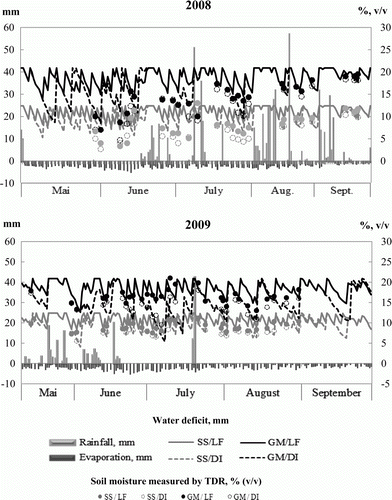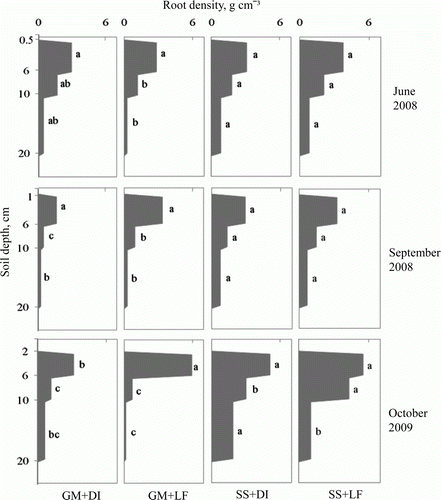Figures & data
Table I. The effect of root zone composition and irrigation regime on mat characteristics of velvet bentgrass green.
Figure 1. Daily soil water deficit as calculated from the difference between rainfall and pan evaporation in 2008 and from 1 May to 20 July 2009, and from pan evaporation after 20 July 2009 (rain-out shelter installed). The plots were irrigated to field capacity each time the calculated soil water deficit exceeded 5 mm, 10 mm, and 20 mm in the treatments SS + LF, SS + DI & SS + LF and GM + DI, respectively. Volumetric soil moisture content in the 0–20 cm rootzone shown with circles and was measured with a time-domain reflectometer (TDR) prior to irrigation of at least one of the four treatments. SS, straight sand; GM, ‘Green Mix’; LF, light and frequent irrigation; DI, deep and infrequent irrigation.

Table II. Effect of root zone composition and irrigation regime on total weight of dry roots per one square meter.
Figure 2. Root density at different soil depths on velvet bentgrass green with root zone compositions straight sand (SS) or ‘Green Mix’ (GM) and irrigation regime light and frequent (LF) or deep and infrequent (DI), measured by the end of dry period in 2008 and the end of both experimental years. Mean values followed by the same letter within the same depth and measured at the same time are not significantly different based on Fisher's protected least significant difference (LSD) test (α = 0.05).

Table III. Effects of root zones and irrigation regimes on infiltration rates measured by double-ring infiltrometer.
Figure 3. Effects of root zone composition and irrigation regimes on playing quality of velvet bentgrass green in 2007, 2008, and 2009. Vertical bars are Fisher's protected least significant difference (LSD) values indicating significant differences between treatments at 5% probability level. SS, straight sand; GM, ‘Green Mix’; LF, light and frequent irrigation; DI, deep and infrequent irrigation.
